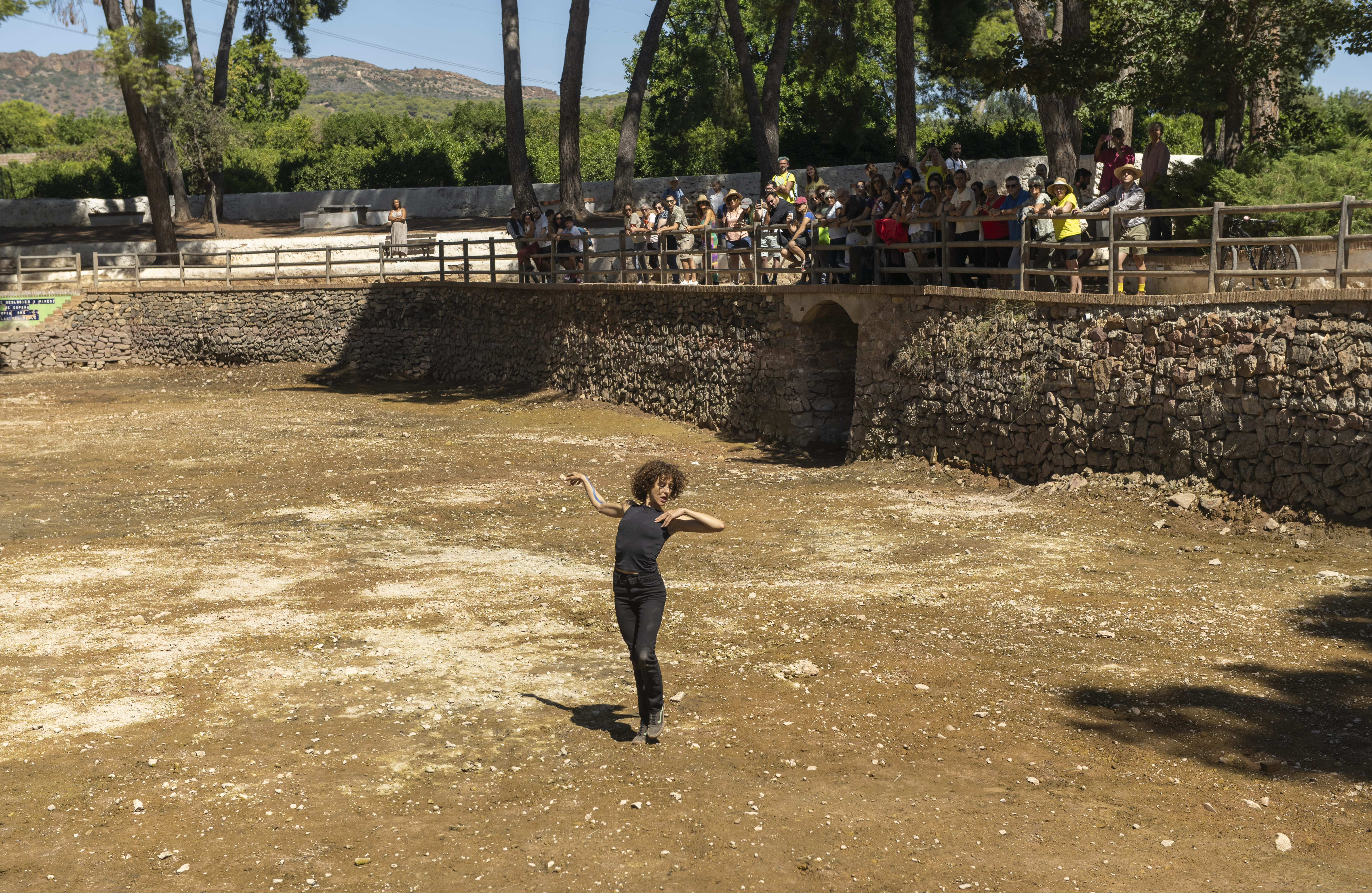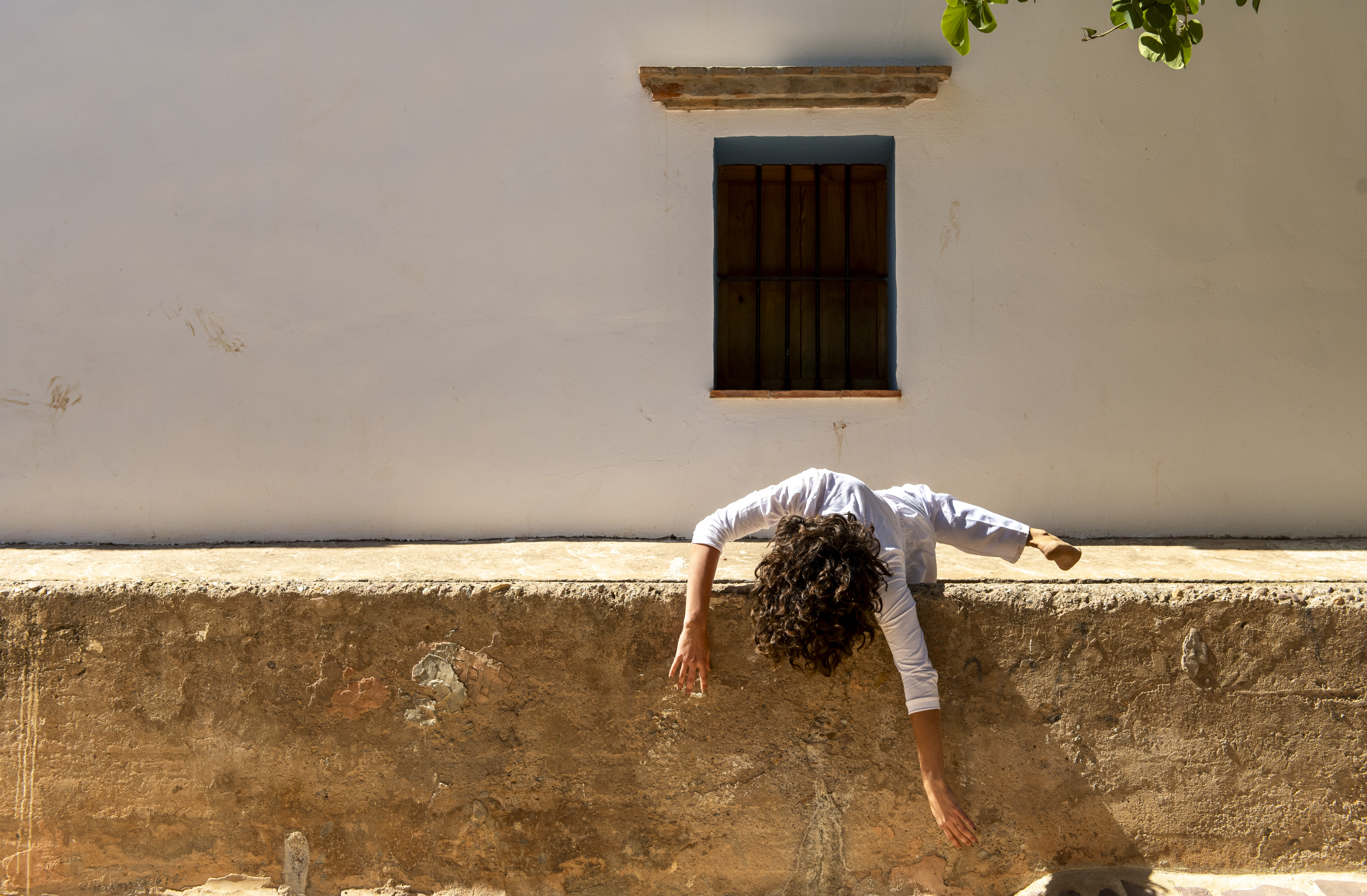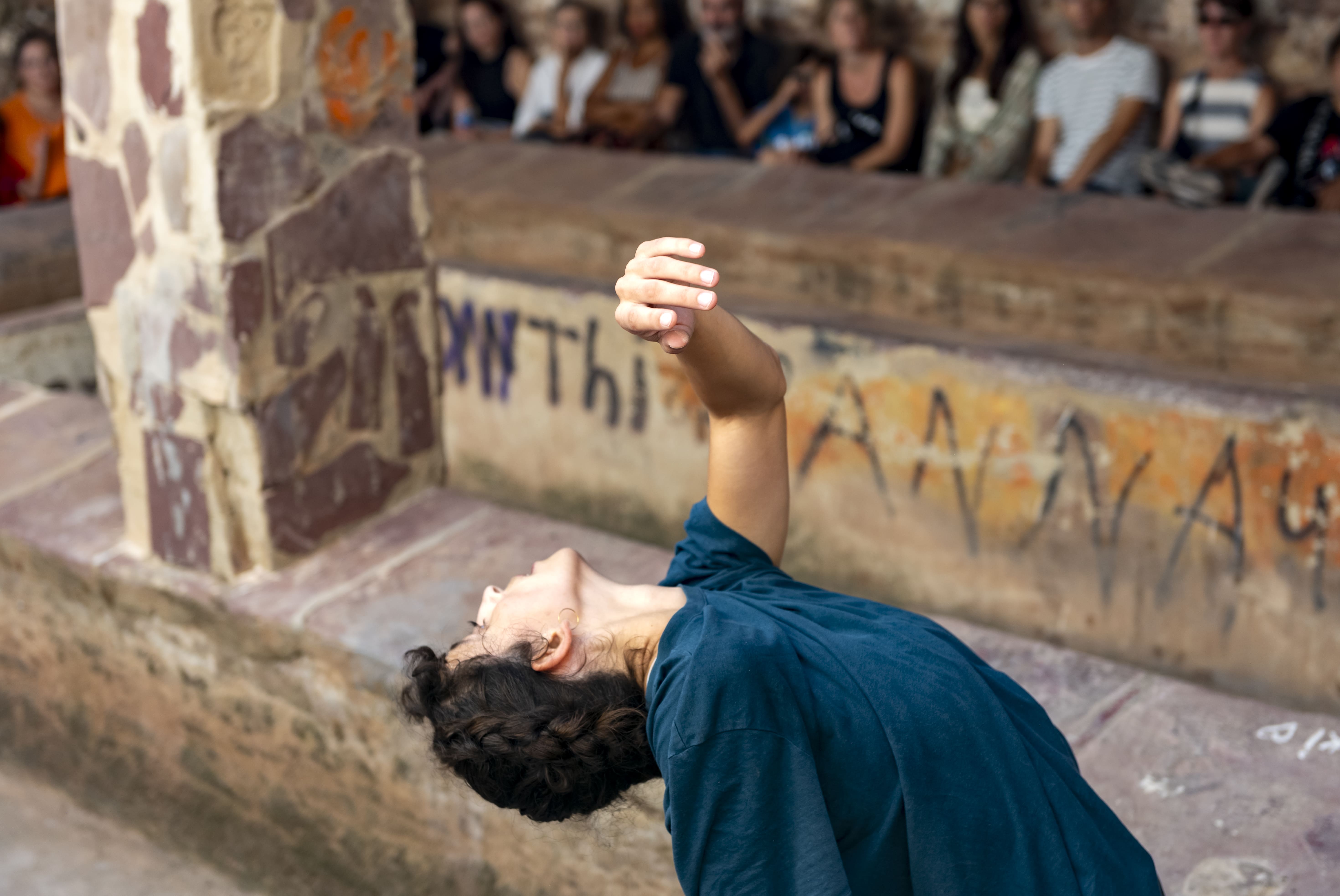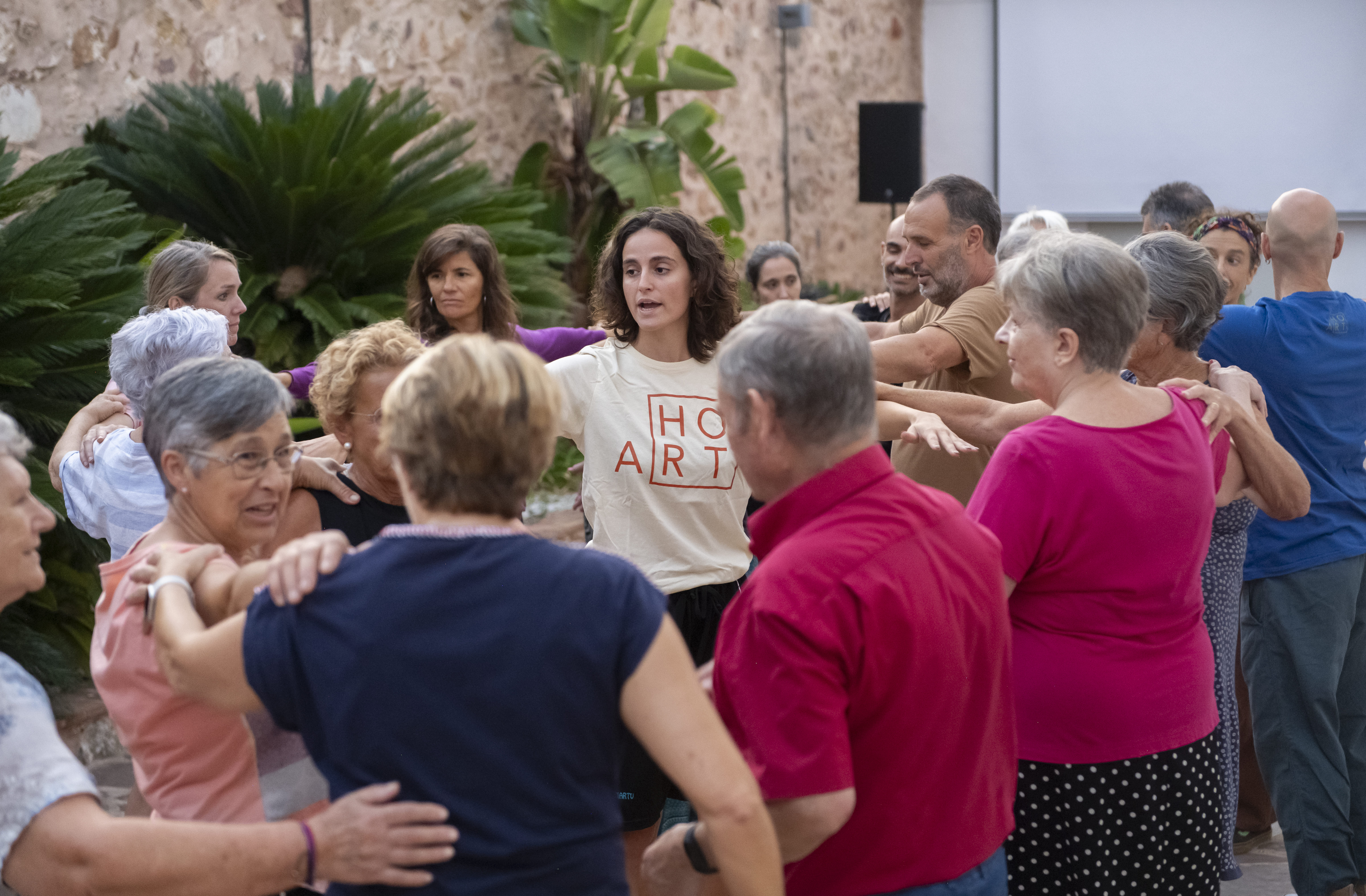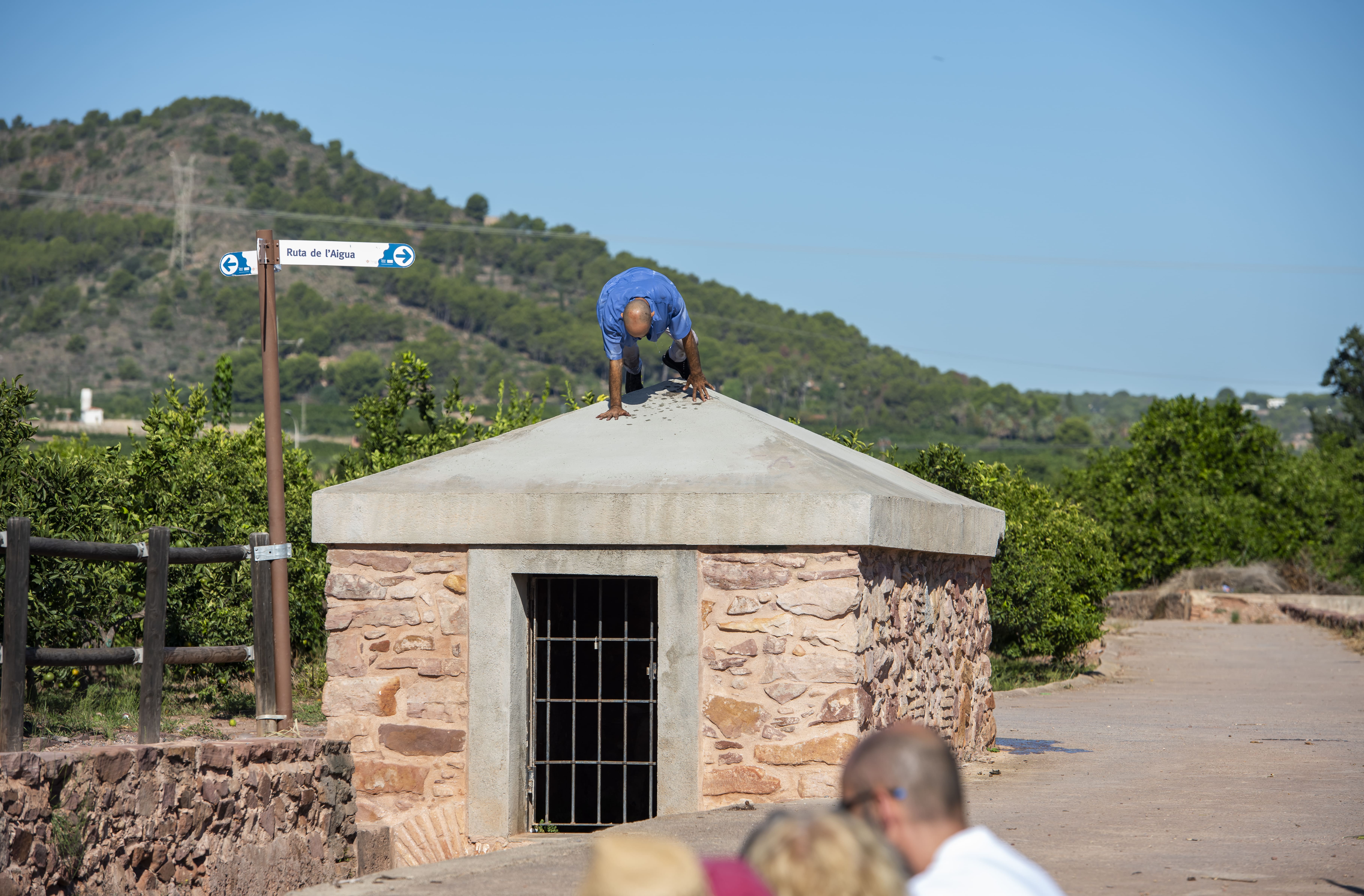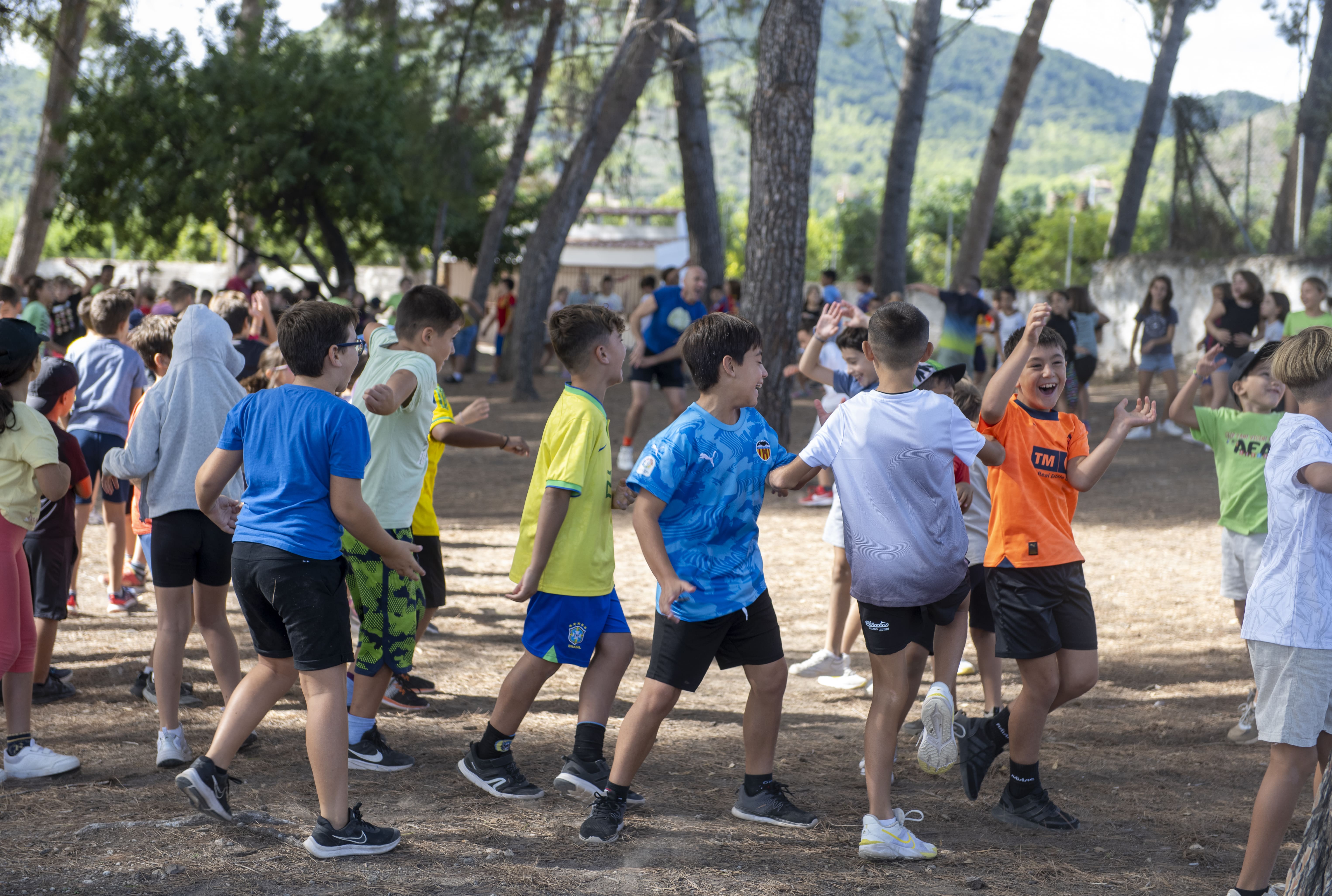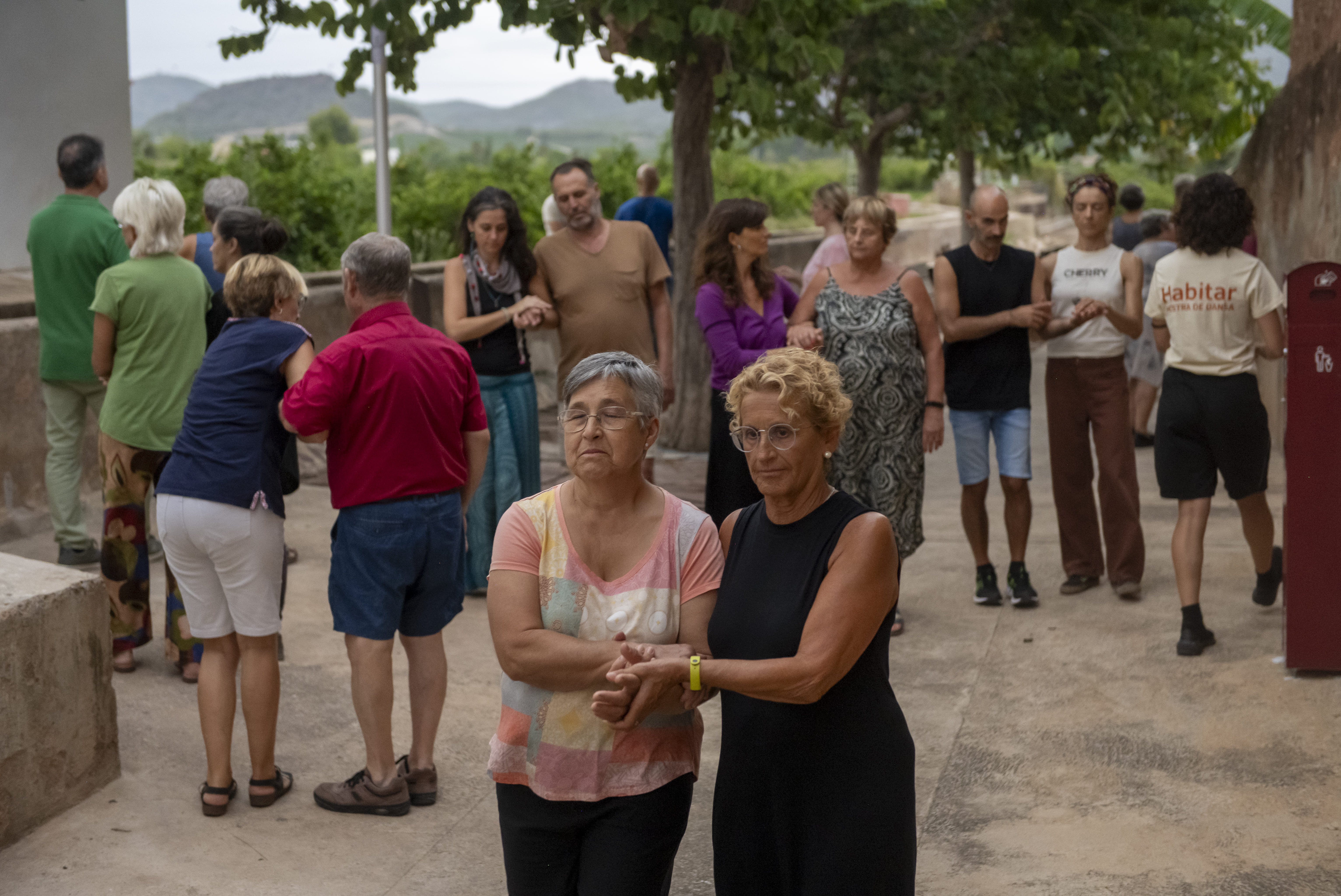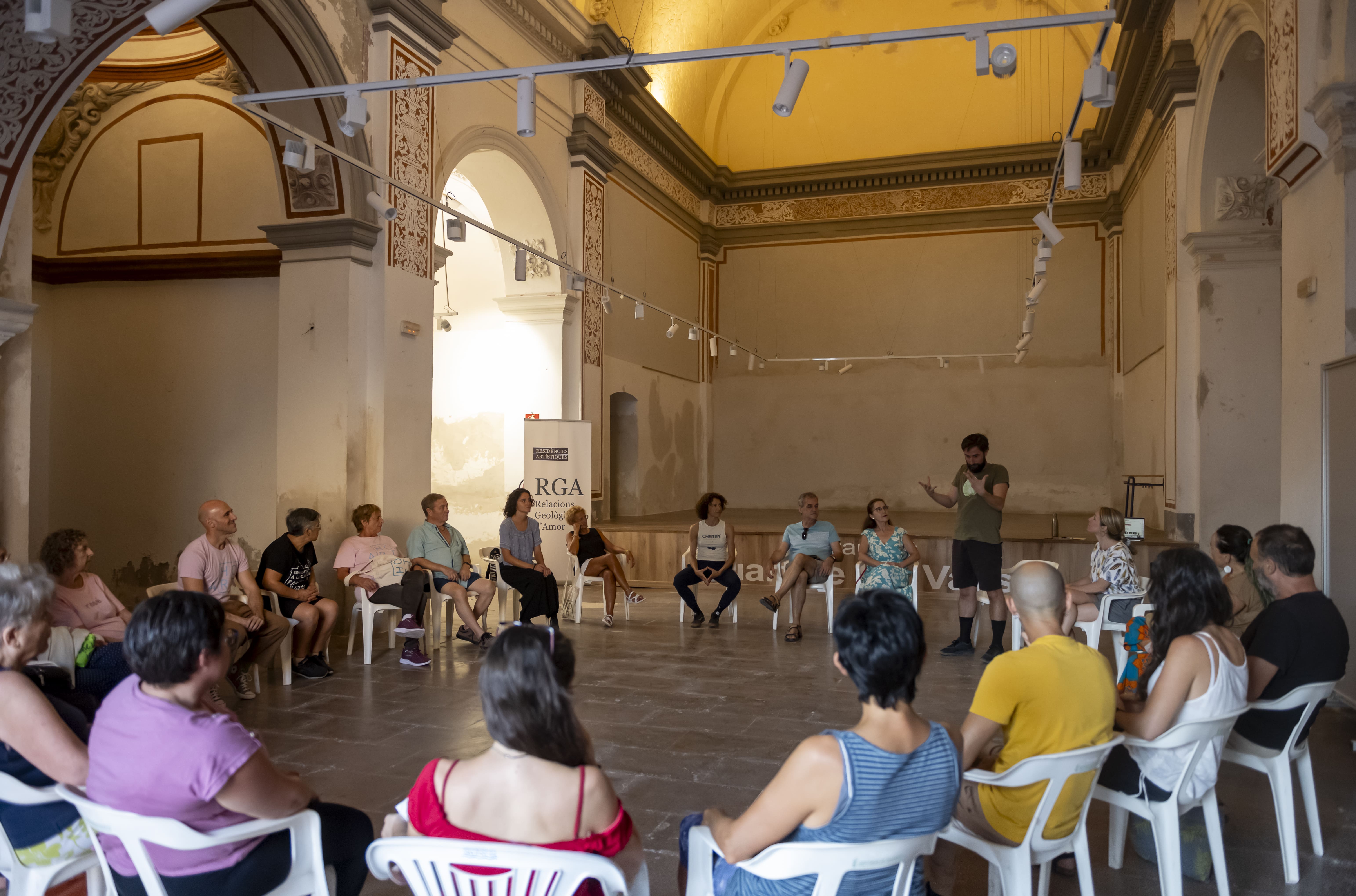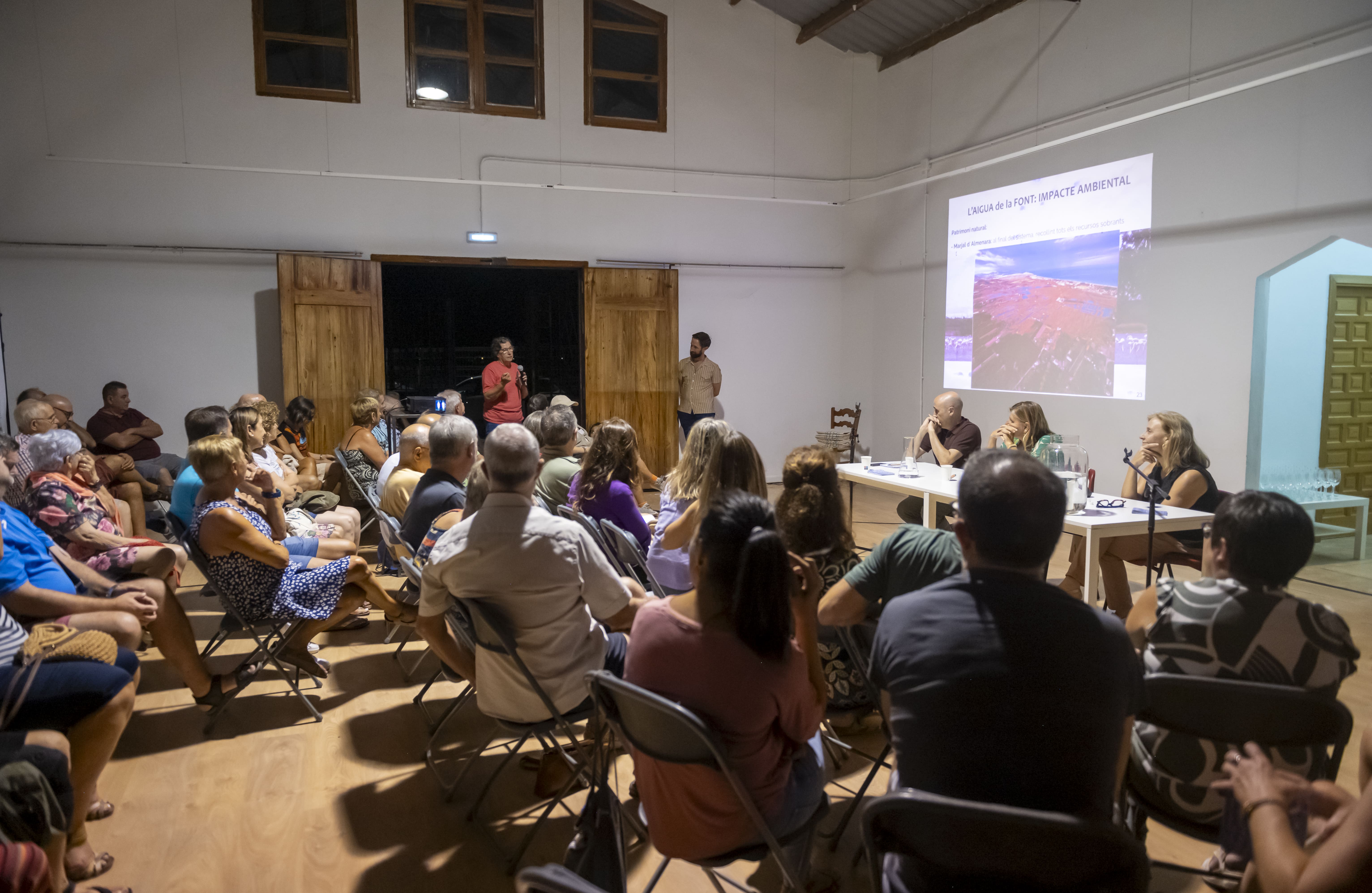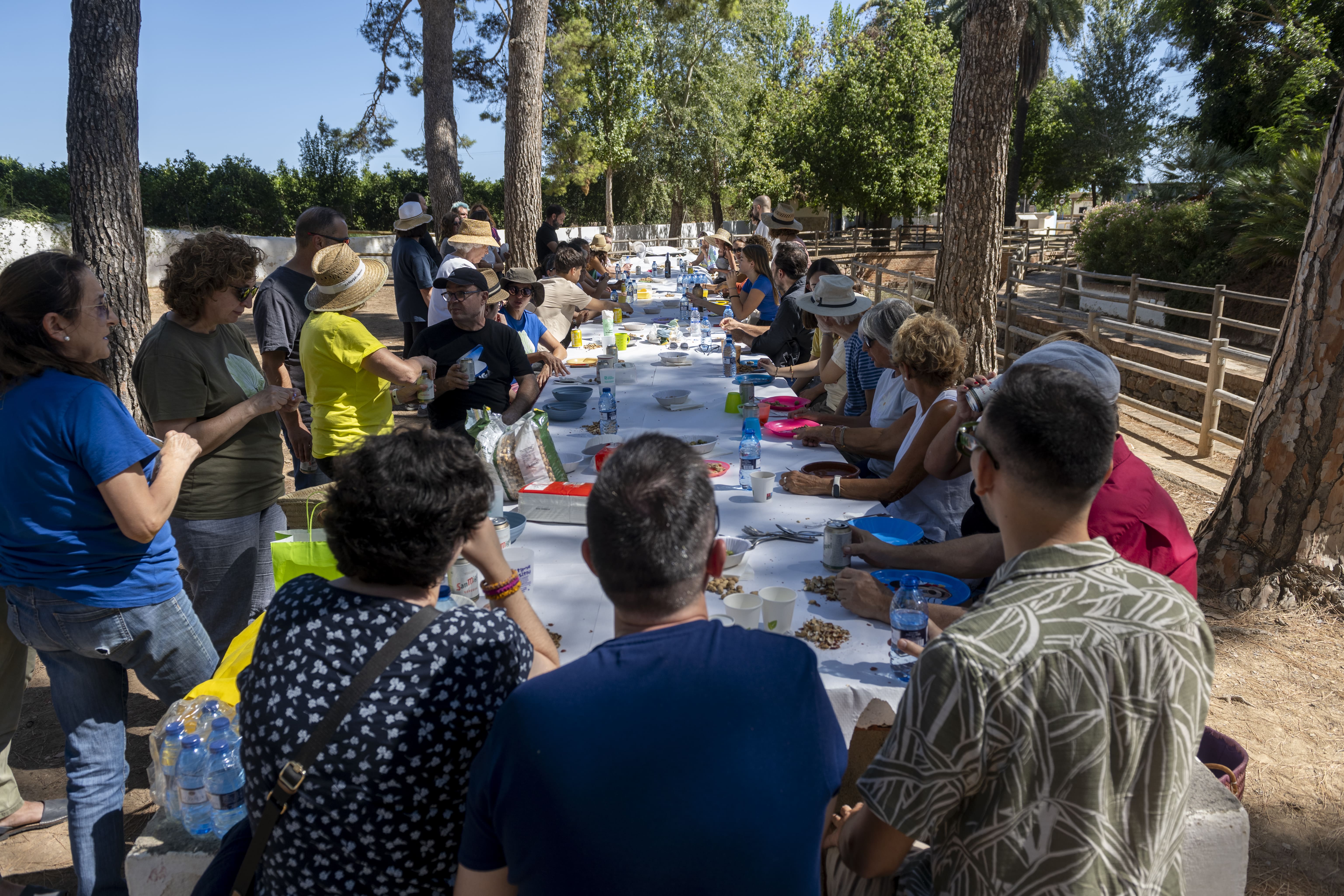Regaining a sense of belonging
WATER- GEOLOGICAL RELATIONS OF LOVE
STRATEGIC PLAN FOR VERTEBRATION OF TERRITORY THROUGH DANCE & ARTS IN CONNECTION WITH ENVIRONMENT
AIGUA-RGA is a project that reconnects the citizens of the towns in the rural area of the Vall de Segó, with the closest natural and cultural environment, promoting the feeling of belonging to this agricultural area and to the historical hydraulic heritage of the Font de Quart, through the articulation of actions that combine dance and living arts, traditional knowledge and community action, following the principles of sustainability, inclusion and aesthetic experience promoted by the NEB.
Spain
Regional
The historic region of Vall de Segó in Valencia province, made up of the municipalities of Faura, Benifairó de les Valls, Quart de les Valls and Quartell.
Mainly rural
It refers to other types of transformations (soft investment)
Yes
2024-09-17
No
No
No
As a representative of an organisation
Aigua-RGA is an artistic project to bring together the Vall de Segó community, developing a sensitivity that contributes to reinforce the identity of the area and the community feeling of belonging, through dance and living arts. The water roads originated the communities of this territory, making irrigated cultivation possible, and it is in the enhancement of this historical heritage through the arts where the power of the project is found.
Target groups are both the community and the individuals involved in it, artists, researchers and institutions. In relation to the direct beneficiaries, intergenerationality has been promoted, as well as specific activities for children.
The specific objectives are:
- Uniting the community based on pride of belonging and principles of care.
- Revitalizing local heritage, promoting artistic exhibition in unconventional spaces, valuing the signs of identity.
- Promoting exchange between artists and community, valuing the interaction between dance and environment, and linking innovation with tradition.
- Forming new audiences, giving access to cultural rights in all geographies, strengthening peripheral communities.
- Supporting interdisciplinarity by activating collaborations between disciplines, institutions, artists and community, encouraging sustainability, understood as social and economic development, through long-term planning.
General participation rates and high participation of male audiences, sometimes still reluctant in this context, show great acceptance and a real need for the project. Given the importance of the theme and the varied range of proposals, participation have tended towards intergenerationality.
In all activities, an ideal environment has been created in which links have been forged that strengthen the relationship between individuals, and the enjoyment of shared artistic experiences that give pride to the sense of belonging. Culture opens a space for an experience of the common.
Target groups are both the community and the individuals involved in it, artists, researchers and institutions. In relation to the direct beneficiaries, intergenerationality has been promoted, as well as specific activities for children.
The specific objectives are:
- Uniting the community based on pride of belonging and principles of care.
- Revitalizing local heritage, promoting artistic exhibition in unconventional spaces, valuing the signs of identity.
- Promoting exchange between artists and community, valuing the interaction between dance and environment, and linking innovation with tradition.
- Forming new audiences, giving access to cultural rights in all geographies, strengthening peripheral communities.
- Supporting interdisciplinarity by activating collaborations between disciplines, institutions, artists and community, encouraging sustainability, understood as social and economic development, through long-term planning.
General participation rates and high participation of male audiences, sometimes still reluctant in this context, show great acceptance and a real need for the project. Given the importance of the theme and the varied range of proposals, participation have tended towards intergenerationality.
In all activities, an ideal environment has been created in which links have been forged that strengthen the relationship between individuals, and the enjoyment of shared artistic experiences that give pride to the sense of belonging. Culture opens a space for an experience of the common.
Community
Identity
Dance
Rurality
Sustainability
Sustainability of the project focuses on three axes: respect for the environment, strengthening the community and economic viability, which guarantee the continuation of long-term activity. We approach it from the following key objectives:
Environmental:
1. Raising awareness of the responsible use of water resources, in reference to SDG6.
2. Encouraging shared transportation and the use of bicycles in activities.
3. Reducing energy consumption (technical equipment) to a minimum in our programming.
4. Digitizing production, office and dissemination material.
5. Promoting the differentiated collection and responsible use of water and electricity in venues.
6. Reconnecting community with its natural environment, giving value to the preservation of the hydraulic network.
Social:
1. Promoting activities where neighbors are active participants, feeling integrated in the project.
2. Identifying needs and desires through direct and ongoing interaction with neighbors.
3.Connecting with the existing realities, weaving a collaborative network with local associations and individuals, to find common objectives.
Economic:
1. Weaving alliances with public institutions at the local, provincial and regional levels.
2. Articulating activities with the direct support of other associations.
3. Seeking support from the community, based on voluntary contributions as well as other cultural entities and private initiatives.
Achieved results are very satisfactory since community has shown great interest in the topic, with high participation and loyalty. There have been important alliances with local associations: Acció Ecologista Agró, Centre Excursionista, Escola Danses Faura and school centers. Four local councils, Association of Professional Dancers of Comunidad Valenciana & Valencian Institute of Culture have given their support.
All this shows us the great role of Arts as an activator of sensibilities, in favor of a more sustainable society in all aspects.
Environmental:
1. Raising awareness of the responsible use of water resources, in reference to SDG6.
2. Encouraging shared transportation and the use of bicycles in activities.
3. Reducing energy consumption (technical equipment) to a minimum in our programming.
4. Digitizing production, office and dissemination material.
5. Promoting the differentiated collection and responsible use of water and electricity in venues.
6. Reconnecting community with its natural environment, giving value to the preservation of the hydraulic network.
Social:
1. Promoting activities where neighbors are active participants, feeling integrated in the project.
2. Identifying needs and desires through direct and ongoing interaction with neighbors.
3.Connecting with the existing realities, weaving a collaborative network with local associations and individuals, to find common objectives.
Economic:
1. Weaving alliances with public institutions at the local, provincial and regional levels.
2. Articulating activities with the direct support of other associations.
3. Seeking support from the community, based on voluntary contributions as well as other cultural entities and private initiatives.
Achieved results are very satisfactory since community has shown great interest in the topic, with high participation and loyalty. There have been important alliances with local associations: Acció Ecologista Agró, Centre Excursionista, Escola Danses Faura and school centers. Four local councils, Association of Professional Dancers of Comunidad Valenciana & Valencian Institute of Culture have given their support.
All this shows us the great role of Arts as an activator of sensibilities, in favor of a more sustainable society in all aspects.
The human body in the landscape reveals its details, intensifies them, giving new aesthetic readings to already known places. Dance and body arts imply aesthetics, collecting plastic elements that make up a coherent and dynamic composition.
Dance in union with a natural environment enhances its beauty and feeds the sensitivity of the human body in movement. An ephemeral composition that remains imprinted in the public's memory, generating new memories related to that same environment, creating new collective imaginaries.
In this sense Aigua-RGA aims:
-Creating a performative act from the union between the background and career of each artist and the specificity of a specific space. A dialogue between Arts and the architectural and natural heritage of the environment.
- Rebelling the everyday landscape from the presence of the foreigner, and from estrangement, enhancing details that go unnoticed by the local gaze.
- Participating in a community artistic experience in the closest environment, both as an agent and as a recipient.
- Using dance as a device for observing the body in relation to the natural and heritage spaces of the hydraulic network of the Font de Quart.
- Creating a network of shared experiences, in spaces that already have a collective memory, which creates and develops imaginaries of the territory and a feeling of belonging from the experimentation of the lived spaces.
-Using Arts as an aesthetic device and to raise awareness of the environment and the community that is created.
To achieve these objectives, the Hort-Art team has had the participation of five artists in residence for ten days who have developed a site-specific investigation, which they have shared with the public in a performative tour.
We have also invited the public to participatory activities in which they have experienced the work methodologies of the resident artists, and in other activities such as dance workshops, dance video visualizations, etc.
Dance in union with a natural environment enhances its beauty and feeds the sensitivity of the human body in movement. An ephemeral composition that remains imprinted in the public's memory, generating new memories related to that same environment, creating new collective imaginaries.
In this sense Aigua-RGA aims:
-Creating a performative act from the union between the background and career of each artist and the specificity of a specific space. A dialogue between Arts and the architectural and natural heritage of the environment.
- Rebelling the everyday landscape from the presence of the foreigner, and from estrangement, enhancing details that go unnoticed by the local gaze.
- Participating in a community artistic experience in the closest environment, both as an agent and as a recipient.
- Using dance as a device for observing the body in relation to the natural and heritage spaces of the hydraulic network of the Font de Quart.
- Creating a network of shared experiences, in spaces that already have a collective memory, which creates and develops imaginaries of the territory and a feeling of belonging from the experimentation of the lived spaces.
-Using Arts as an aesthetic device and to raise awareness of the environment and the community that is created.
To achieve these objectives, the Hort-Art team has had the participation of five artists in residence for ten days who have developed a site-specific investigation, which they have shared with the public in a performative tour.
We have also invited the public to participatory activities in which they have experienced the work methodologies of the resident artists, and in other activities such as dance workshops, dance video visualizations, etc.
We understand that the democratization of culture involves the elimination of barriers, allowing free and quality access to culture in peripheral realities like ours and at the same time providing tools so that the public can enjoy the most enriching experience. In favor of this inclusivity Aigua-RGA aims to:
1- Offering the activities free of charge and open to all audiences. The dissemination of programming covers both digital and local channels, in direct contact with citizens.
2- Planning and studying activities to reach all the different groups that make up the heterogeneity of our community, promoting intergenerationality in most of them. Also organizing specific activities for specific groups: children, older people, farmers, etc.
3- Attracting the participation of artists, local, national & international, through open calls, eliminating geographical barriers and prejudices.
4- Ensuring accessibility to natural spaces for people with reduced mobility or visibility.
5- Discrediting the belief that Performing Arts need a conventional building (theater, auditorium), promoting artistic experiences in unconventional spaces, making up for the lack of these buildings and taking advantage of the characteristics of other spaces.
6- Promoting a horizontal government system, directed by a board of directors made up of three women and one man, in which the opinion of the community influences the programming of activities.
The exemplary nature of the project lies in the fact that our focus is the community, understood from within, taking care of and embracing all diversities, offering quality programming, free and accessible, building bridges of mediation between tradition and contemporaneity. Dance and Arts should not be an elitist privilege but a universal right, where everyone can appreciate it based on their own reading tools. As the project progresses, these tools make the community feel empowered, expanding their knowledge and appreciation capacities.
1- Offering the activities free of charge and open to all audiences. The dissemination of programming covers both digital and local channels, in direct contact with citizens.
2- Planning and studying activities to reach all the different groups that make up the heterogeneity of our community, promoting intergenerationality in most of them. Also organizing specific activities for specific groups: children, older people, farmers, etc.
3- Attracting the participation of artists, local, national & international, through open calls, eliminating geographical barriers and prejudices.
4- Ensuring accessibility to natural spaces for people with reduced mobility or visibility.
5- Discrediting the belief that Performing Arts need a conventional building (theater, auditorium), promoting artistic experiences in unconventional spaces, making up for the lack of these buildings and taking advantage of the characteristics of other spaces.
6- Promoting a horizontal government system, directed by a board of directors made up of three women and one man, in which the opinion of the community influences the programming of activities.
The exemplary nature of the project lies in the fact that our focus is the community, understood from within, taking care of and embracing all diversities, offering quality programming, free and accessible, building bridges of mediation between tradition and contemporaneity. Dance and Arts should not be an elitist privilege but a universal right, where everyone can appreciate it based on their own reading tools. As the project progresses, these tools make the community feel empowered, expanding their knowledge and appreciation capacities.
Citizens have actively participated in the project in its different phases.
In the ideation phase we have met with different agents or representatives of citizens to document different aspects of the project, taking into account their points of view resulting from experience, their conflicts and desires. During an initial stage we choose and identify who could be the local people with greater knowledge on issues related to water resources, their use and reality, the geography of the area, the current danger factors and the traditional knowledge related to it.
Among the neighbors interviewed, we met among others with neighbors with a high environmental commitment, members of the Center Cultural Excursionista la Vall de Segó, farmers, housewives, users of l'Espai dels Majors, members of the Escola de Danses de Faura, the main controller of the Font de Quart, etc.
During the development phase, the community has actively participated in the workshops led by the resident artists, in the “L'Aigua de les Valls” conference, opening dialogue with the competent authorities, as an audience in the different dance exhibitions, etc.
This participation has encouraged interest in the project, since citizens have felt it as their own, not only because of the proximity of the theme, but also because of the way of integrating them from the beginning, taking into account their contributions. In the same way, on an artistic level, it has contributed to supporting the proposals of artists who have felt supported by a community willing to see their own landscape from the perspective of the artist/foreigner.
In the evaluation phase we have encouraged the public to share with us their feedback, which has been very positive and satisfactory, which makes us affirm that the project is necessary for our citizens.
In the ideation phase we have met with different agents or representatives of citizens to document different aspects of the project, taking into account their points of view resulting from experience, their conflicts and desires. During an initial stage we choose and identify who could be the local people with greater knowledge on issues related to water resources, their use and reality, the geography of the area, the current danger factors and the traditional knowledge related to it.
Among the neighbors interviewed, we met among others with neighbors with a high environmental commitment, members of the Center Cultural Excursionista la Vall de Segó, farmers, housewives, users of l'Espai dels Majors, members of the Escola de Danses de Faura, the main controller of the Font de Quart, etc.
During the development phase, the community has actively participated in the workshops led by the resident artists, in the “L'Aigua de les Valls” conference, opening dialogue with the competent authorities, as an audience in the different dance exhibitions, etc.
This participation has encouraged interest in the project, since citizens have felt it as their own, not only because of the proximity of the theme, but also because of the way of integrating them from the beginning, taking into account their contributions. In the same way, on an artistic level, it has contributed to supporting the proposals of artists who have felt supported by a community willing to see their own landscape from the perspective of the artist/foreigner.
In the evaluation phase we have encouraged the public to share with us their feedback, which has been very positive and satisfactory, which makes us affirm that the project is necessary for our citizens.
The stakeholders of this project are at the national level: the artists in residence; at the regional level: the Xúquer Hydrographic Confederation, the Polytechnic University of Valencia and the Institut Valencià de Cultura; and at the local level: Acció Ecologista Agró, Center Excursionista la Vall de Segó, the town councils of the Vall de Segó, local farmers and the community.
Artists: They have participated in the design of the artistic proposals and the dance workshops, as well as in their execution. The role of their participation is fundamental, since it is through artistic proposals that awareness about the territory is produced.
The Polytechnic University of Valencia has helped to provide a theoretical framework for the design of the project, through the commitment of Dr. Inmaculada Marqués. Her participation in the “L’Aigua de les Valls” conference has explained the value of hydraulic heritage.
The Xúquer Hydrographic Confederation, contributed the practical and governmental part, in the conference, explaining on behalf of its president, Miguel Polo, the drought situation of the Algar-Les Valls aquifer and explained the reason for the situation.
The environmental association Agró has contributed with all its experience in the territory to the design of the project, as well as participating with educational materials, an exhibition and the screening of a documentary.
The Vall de Segó hiking center proposed routes in relation to the hydraulic network, guiding the “Amerats de Lluna” activity.
The local town councils, as well as the Institut Valencià de Cultura, have financed the project, understanding the importance for their citizens.
At the local level, farmers in the area helped design the project by proposing their conflicts and difficulties in relation to the use of water resources.
The community actively participated in all phases of the project, making it make sense.
Artists: They have participated in the design of the artistic proposals and the dance workshops, as well as in their execution. The role of their participation is fundamental, since it is through artistic proposals that awareness about the territory is produced.
The Polytechnic University of Valencia has helped to provide a theoretical framework for the design of the project, through the commitment of Dr. Inmaculada Marqués. Her participation in the “L’Aigua de les Valls” conference has explained the value of hydraulic heritage.
The Xúquer Hydrographic Confederation, contributed the practical and governmental part, in the conference, explaining on behalf of its president, Miguel Polo, the drought situation of the Algar-Les Valls aquifer and explained the reason for the situation.
The environmental association Agró has contributed with all its experience in the territory to the design of the project, as well as participating with educational materials, an exhibition and the screening of a documentary.
The Vall de Segó hiking center proposed routes in relation to the hydraulic network, guiding the “Amerats de Lluna” activity.
The local town councils, as well as the Institut Valencià de Cultura, have financed the project, understanding the importance for their citizens.
At the local level, farmers in the area helped design the project by proposing their conflicts and difficulties in relation to the use of water resources.
The community actively participated in all phases of the project, making it make sense.
Different disciplines and knowledge feed into the design and implementation of Aigua-RGA, all of them related to Arts (dance, body arts, plastic arts), to the study of the Environment (ecology, agriculture, geology, development of the agricultural economy) and to Thought (philosophy, anthropology and sociology).
ARTS:
Resident artists (Francisco Ruz, Teresa Lorenzo, Inés Sarmiento, Cristina Valdivielso, Elisa Arteta and Ana Lola Cosín) chosen by open call, based on dance-environment, helped to design their proposals and workshops, which were interpreted and taught by them.
Ricard Balanzà, professor at the Escuela de Arte Superior de Ceràmica de Valencia, proposed a series of clay materials to create the project image, based on the study of the geography and textures of water
Hort-Art: Pere Bodí, co-director, dancer and teacher at the Escuela Superior de Arte Dramático de las Islas Baleares, and Alex Guerra, co-director, dancer, choreographer and Feldenkrais instructor, designed and implemented all the activities.
ENVIRONMENT:
Enric Amer, as a reference in Acció Ecologista Agró, participated actively in the previous meetings, in the conference, and in the rest of the activities.
Immaculada Marqúes, from the UPV. With previous conversations and participating in the opening conference of the project.
Miguel Polo Cebellán, from the Confederació Hidrográfica del Xúquer. Participating in the conference.
THOUGHT:
Dr. Albert Ferrer, philosopher from the UOC, Open University of Catalonia. He participated in the previous reflection and gave a talk reflecting on the relationship with the body.
Each of the experts in the different fields contributed their knowledge and solidity to design the project. The relevance of each of these representatives and their institutions helped in the implementation of the project, given their commitment and in many cases the direct relationship with the territory of the Vall de Segó.
ARTS:
Resident artists (Francisco Ruz, Teresa Lorenzo, Inés Sarmiento, Cristina Valdivielso, Elisa Arteta and Ana Lola Cosín) chosen by open call, based on dance-environment, helped to design their proposals and workshops, which were interpreted and taught by them.
Ricard Balanzà, professor at the Escuela de Arte Superior de Ceràmica de Valencia, proposed a series of clay materials to create the project image, based on the study of the geography and textures of water
Hort-Art: Pere Bodí, co-director, dancer and teacher at the Escuela Superior de Arte Dramático de las Islas Baleares, and Alex Guerra, co-director, dancer, choreographer and Feldenkrais instructor, designed and implemented all the activities.
ENVIRONMENT:
Enric Amer, as a reference in Acció Ecologista Agró, participated actively in the previous meetings, in the conference, and in the rest of the activities.
Immaculada Marqúes, from the UPV. With previous conversations and participating in the opening conference of the project.
Miguel Polo Cebellán, from the Confederació Hidrográfica del Xúquer. Participating in the conference.
THOUGHT:
Dr. Albert Ferrer, philosopher from the UOC, Open University of Catalonia. He participated in the previous reflection and gave a talk reflecting on the relationship with the body.
Each of the experts in the different fields contributed their knowledge and solidity to design the project. The relevance of each of these representatives and their institutions helped in the implementation of the project, given their commitment and in many cases the direct relationship with the territory of the Vall de Segó.
The innovative dimension of the project lies in two fundamental axes, the interaction between Art and Territory, and the way in which the project is born from the community.
Dance and Body Arts come into contact with the territory in a symbiosis in which both parts feed off each other. The artists make their poetics reverberate in the chosen spaces related to water, and on the other hand, these spaces, devoid of technical artifice, place the artists oin the spotlight. The Sistar de Faura (water distributor between the irrigation ditches), the Llavaner de Faura and the Llavaner de Benifairó (historic laundry spaces fed by running water), the Molí Nou de Quartell (a historic water mill) and the Font de Quart (the main water spring) are constructions that still endure from this framework that gave life to the territory. Due to the extraordinary drought and the poor use of resources, the Font de Quart has been dry for the first time in recent months, and consequently all the spaces have no water. The redefinition of these spaces, identifying signs of the territory, raises awareness about their importance and about the climate emergency.
The project is born from the community, in this case from within, from the concern of citizens due to extraordinary drought circumstances. The water that flows from the water spring, for the inhabitants of the Vall de Segó, has always been a symbol of life and union between the six municipalities that are supplied with this water.
Access to artistic expressions is complicated in the peripheral areas, and the measures that try to alleviate this are insufficient and disconnected from the realities, causing the public to have no interest in them. When dance is done from and in the landscape where it has grown, the connection is immediate, and everything makes sense.
That is why the innovative character lies in raising awareness through Arts, but through Arts that are connected to the territory and its identifying features.
Dance and Body Arts come into contact with the territory in a symbiosis in which both parts feed off each other. The artists make their poetics reverberate in the chosen spaces related to water, and on the other hand, these spaces, devoid of technical artifice, place the artists oin the spotlight. The Sistar de Faura (water distributor between the irrigation ditches), the Llavaner de Faura and the Llavaner de Benifairó (historic laundry spaces fed by running water), the Molí Nou de Quartell (a historic water mill) and the Font de Quart (the main water spring) are constructions that still endure from this framework that gave life to the territory. Due to the extraordinary drought and the poor use of resources, the Font de Quart has been dry for the first time in recent months, and consequently all the spaces have no water. The redefinition of these spaces, identifying signs of the territory, raises awareness about their importance and about the climate emergency.
The project is born from the community, in this case from within, from the concern of citizens due to extraordinary drought circumstances. The water that flows from the water spring, for the inhabitants of the Vall de Segó, has always been a symbol of life and union between the six municipalities that are supplied with this water.
Access to artistic expressions is complicated in the peripheral areas, and the measures that try to alleviate this are insufficient and disconnected from the realities, causing the public to have no interest in them. When dance is done from and in the landscape where it has grown, the connection is immediate, and everything makes sense.
That is why the innovative character lies in raising awareness through Arts, but through Arts that are connected to the territory and its identifying features.
The project is based on the principles of inclusive methodologies and approaches, and from horizontality understood from the differentiated tasks of each agent, embracing diversity and individual contributions.
We understand community not as a homogeneous mass but as the sum of so many singularities, with their different needs, concerns, thoughts and ways of doing things, organizing activities for the general public and other more specific ones for different groups.
The design is born from active listening to the territory. Continuous contact with a community for more than ten years, as well as having the majority of our team who are originally from this community. Listening to the needs from within without imposing a preconceived idea with condescension from the outside is our main focus.
Hort-Art's continued mediation in the territory dilutes the barriers between artists/organizers/researchers - general community. We know our neighbors, and their diversities, and we try to give them tools to foster their critical spirit and reflect deeply on what we present to them.
On the other hand, in terms of working with the artists who come in residence, we provide them with logistical and artistic support, and meeting spaces with local people so that they can live a rich experience being part of the territory.
Artistically, we accompany the artists by offering them an external view and proposing questions that activate as triggers to deepen their work in relation to the proposal. We accompany the artists, trying not to be invasive, and reinforcing any of their intuitions, enhancing them and trying to materialize within our possibilities and always following principles of sustainability.
We understand community not as a homogeneous mass but as the sum of so many singularities, with their different needs, concerns, thoughts and ways of doing things, organizing activities for the general public and other more specific ones for different groups.
The design is born from active listening to the territory. Continuous contact with a community for more than ten years, as well as having the majority of our team who are originally from this community. Listening to the needs from within without imposing a preconceived idea with condescension from the outside is our main focus.
Hort-Art's continued mediation in the territory dilutes the barriers between artists/organizers/researchers - general community. We know our neighbors, and their diversities, and we try to give them tools to foster their critical spirit and reflect deeply on what we present to them.
On the other hand, in terms of working with the artists who come in residence, we provide them with logistical and artistic support, and meeting spaces with local people so that they can live a rich experience being part of the territory.
Artistically, we accompany the artists by offering them an external view and proposing questions that activate as triggers to deepen their work in relation to the proposal. We accompany the artists, trying not to be invasive, and reinforcing any of their intuitions, enhancing them and trying to materialize within our possibilities and always following principles of sustainability.
The results of this project are adaptable to other territorial contexts that are similar. The strength of the process is the methodology and the process through which it is carried out, which allows for easy replicability as long as there are local partners who know the territory from within.
Artistic residencies for research in dance and body arts and exploration of the territory can contribute a lot to both parties, with the consequent replicability with other artists and in other territories. These residencies open space for research into any territory, finding the details and peculiarities. To do this, the only thing that is necessary is collaboration and knowledge from within to be able to identify, on the one hand, the needs and points to take into account, as well as the way in which to interact and create links with citizens.
Another notable aspect that can help this is the learning that is carried out by both parties. The community, by redefining known and/or everyday spaces, manages to give value to its identity, activating a collective memory with members of the same territory and consequently fostering a feeling of belonging to the territory.
Artists are also affected by this contact and can develop in different places the learning of adaptability to the proposed spaces, as well as permeability with the environment and the everyday life of each community.
Researchers, government corporations and other agents involved can also obtain the benefits of contact with the community in a shared space that helps collaboration between them.
Artistic residencies for research in dance and body arts and exploration of the territory can contribute a lot to both parties, with the consequent replicability with other artists and in other territories. These residencies open space for research into any territory, finding the details and peculiarities. To do this, the only thing that is necessary is collaboration and knowledge from within to be able to identify, on the one hand, the needs and points to take into account, as well as the way in which to interact and create links with citizens.
Another notable aspect that can help this is the learning that is carried out by both parties. The community, by redefining known and/or everyday spaces, manages to give value to its identity, activating a collective memory with members of the same territory and consequently fostering a feeling of belonging to the territory.
Artists are also affected by this contact and can develop in different places the learning of adaptability to the proposed spaces, as well as permeability with the environment and the everyday life of each community.
Researchers, government corporations and other agents involved can also obtain the benefits of contact with the community in a shared space that helps collaboration between them.
The project, with a place-based approach, relies on small-scale initiatives with local communities to address the global challenges of the moment. Today's society urgently needs new approaches that reinforce values of coexistence and responsibility for the common good to generate sustainable public spaces that care for and place people's lives at the centre.
Aigua- Relacions Geològiques d’Amor directly addresses the global water challenge related to SDG 6 of the 2030 agenda "Objective 6: Ensure the availability and sustainable management of water and sanitation for all".
The Font de Quart spring has always been an emblem for the Vall de Segó since this is the reason for the settlement in this region of the original peoples of the area, as well as the link between the current municipalities that still supply themselves with it.
With this project, it has been possible to mobilize residents of the five municipalities united by a common concern. The reflection on the state of the Quart fountain during the year 2024 and the search for factors that cause it, far from generating conflicts of interest, have helped to consolidate a common space in which farmers, environmentalists, researchers, local and regional governments and the general public have agreed and recognized the need to preserve these natural resources. In this way, it has helped to reflect on the use of motors, drip irrigation and the use of water resources.
Another of the global challenges that the project addresses is unwanted loneliness and social isolation. The activities generate a collaborative space where all individuals have a place. Participants participate in shared experiences and feel part of flexible and permeable communities, generating links between them.
Aigua- Relacions Geològiques d’Amor directly addresses the global water challenge related to SDG 6 of the 2030 agenda "Objective 6: Ensure the availability and sustainable management of water and sanitation for all".
The Font de Quart spring has always been an emblem for the Vall de Segó since this is the reason for the settlement in this region of the original peoples of the area, as well as the link between the current municipalities that still supply themselves with it.
With this project, it has been possible to mobilize residents of the five municipalities united by a common concern. The reflection on the state of the Quart fountain during the year 2024 and the search for factors that cause it, far from generating conflicts of interest, have helped to consolidate a common space in which farmers, environmentalists, researchers, local and regional governments and the general public have agreed and recognized the need to preserve these natural resources. In this way, it has helped to reflect on the use of motors, drip irrigation and the use of water resources.
Another of the global challenges that the project addresses is unwanted loneliness and social isolation. The activities generate a collaborative space where all individuals have a place. Participants participate in shared experiences and feel part of flexible and permeable communities, generating links between them.
Aigua-RGA has had an extensive programme of activities that have exceeded all expectations of attendance. Workshops, open exhibitions, presentations that have been of great interest both to attendees and to speakers/researchers/artists.
The concern about the climate emergency and the evident drought in the hydraulic system of the territory has forged the link between towns in this sub-region, identifying the common signs of identity related to the Font de Quart and making visible the need to preserve it.
The activities developed in each municipality have had a very high participation, and activities have also been carried out that encompass all the municipalities, with the final articulation of a performative route.
Publics of all ages, families, teenagers, and older people, have participated in the various activities. Particularly noteworthy is the presentation “El Aigua de les Valls” with the participation and interest of Miguel Polo Cebellán, president of the Xúquer Hydrographic Confederation and Inmaculada Marqués, researcher at the Polytechnic University of Valencia, with more than 80 attendees at the Escorxador de Faura, the dance workshop at the Font de Quart with the schools of the Vall de Segó with the participation of more than 120 students from the second cycle of primary school from four schools with 120 students and the open exhibition day with a total participation of more than 200 people.
The project has also contributed to forging alliances between government institutions, the Town Councils of Faura, Benifairó de les Valls, Quart de les Valls, Quartell and Almenara, the support of the Valencian Institute of Culture, in favour of a community and identity project.
In terms of cultural, sustainable and local tourism, it has served to attract the attention of the public from other geographies in the region, as well as hosting artists from all over Spain to address local themes.
The concern about the climate emergency and the evident drought in the hydraulic system of the territory has forged the link between towns in this sub-region, identifying the common signs of identity related to the Font de Quart and making visible the need to preserve it.
The activities developed in each municipality have had a very high participation, and activities have also been carried out that encompass all the municipalities, with the final articulation of a performative route.
Publics of all ages, families, teenagers, and older people, have participated in the various activities. Particularly noteworthy is the presentation “El Aigua de les Valls” with the participation and interest of Miguel Polo Cebellán, president of the Xúquer Hydrographic Confederation and Inmaculada Marqués, researcher at the Polytechnic University of Valencia, with more than 80 attendees at the Escorxador de Faura, the dance workshop at the Font de Quart with the schools of the Vall de Segó with the participation of more than 120 students from the second cycle of primary school from four schools with 120 students and the open exhibition day with a total participation of more than 200 people.
The project has also contributed to forging alliances between government institutions, the Town Councils of Faura, Benifairó de les Valls, Quart de les Valls, Quartell and Almenara, the support of the Valencian Institute of Culture, in favour of a community and identity project.
In terms of cultural, sustainable and local tourism, it has served to attract the attention of the public from other geographies in the region, as well as hosting artists from all over Spain to address local themes.

